check engine MERCEDES-BENZ E-CLASS CABRIOLET 2010 User Guide
[x] Cancel search | Manufacturer: MERCEDES-BENZ, Model Year: 2010, Model line: E-CLASS CABRIOLET, Model: MERCEDES-BENZ E-CLASS CABRIOLET 2010Pages: 333, PDF Size: 7.64 MB
Page 165 of 333
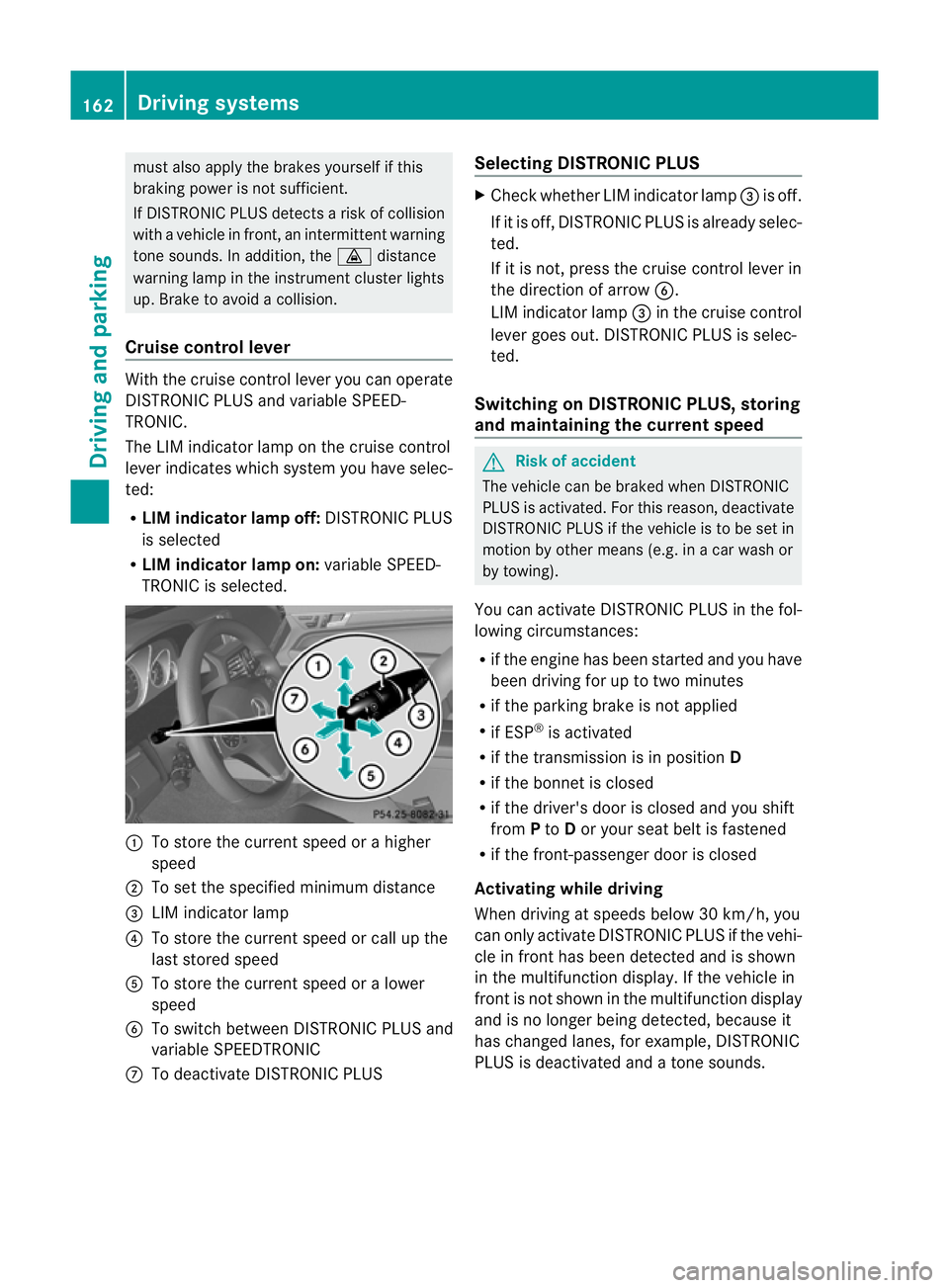
mus
talsoa pply the brakes yourself if this
braking powe risnot sufficient.
If DISTRONIC PLU Sdetect sarisk of collision
with avehicle in front, an intermit tent warning
tone sounds. In addition, the ·distance
warning lamp in the instrument cluste rlights
up. Brak etoavoidac ollision.
Cruise control lever With the cruise control lever you can operate
DI ST RONIC PLUS and variable SPEE D-
TRONIC.
The LI Mindicator lamp on the cruise control
lever indicates which system you have selec-
ted:
R LIM indicator lamp off: DISTRONIC PLUS
is selected
R LIM indicator lamp on: variable SPEED-
TRONIC is selected. :
To sto rethe curren tspeed or ahigher
speed
; To set the specified minimum distance
= LIMi ndicator lamp
? To sto rethe curren tspeed or call up the
last stored speed
A To stor ethe curren tspeed or alower
speed
B To switc hbetween DI STRONIC PLUS and
variable SPEEDTRONIC
C To deactivate DISTRONIC PLUS Selecting DISTRONIC PLUS X
Check whether LIM indicator lamp =is off.
If it is off, DISTRONIC PLUS is already selec-
ted.
If it is not ,pres sthe cruise contr ol leverin
the direction of arrow B.
LIM indicator lamp =in the cruise control
lever goe sout. DISTRONIC PLUS is selec-
ted.
Switching on DISTRONIC PLUS ,storing
and maintaining the current speed G
Risk of accident
The vehicle can be braked when DISTRONIC
PLUS is activated. For this reason, deactivate
DISTRONIC PLUS if the vehicle is to be set in
motion by othe rmeans (e.g. in acar wash or
by towing).
You can activate DISTRONIC PLUS in the fol-
lowing circumstances:
R if the engine has been started and you have
been drivin gfor up to two minutes
R if the parkin gbrake is not applied
R if ESP ®
is acti vated
R if the transmission is in position D
R if the bonnet is closed
R if the driver' sdoor is closed and you shift
from Pto Dor your seat belt is fastened
R if the front-passenger door is closed
Activating while driving
When drivin gatspeeds below 30 km/h, you
can only acti vate DISTRONIC PLUS if the vehi-
cle in fron thas been detected and is shown
in the multifunction display. If the vehicle in
front is not shown in the multifunction display
and is no longe rbeing detected, because it
has changed lanes, for example, DISTRONIC
PLU Sisd eactivated and atone sounds. 162
Driving systemsDriving and pa
rking
BA 20 7ECE ÄJ 2010 /1a; 1; 2, en-GB
mkalafa Version: 3.0.2.11 2010-01-26T13:03:22+01:00 -Seite 162
Page 191 of 333
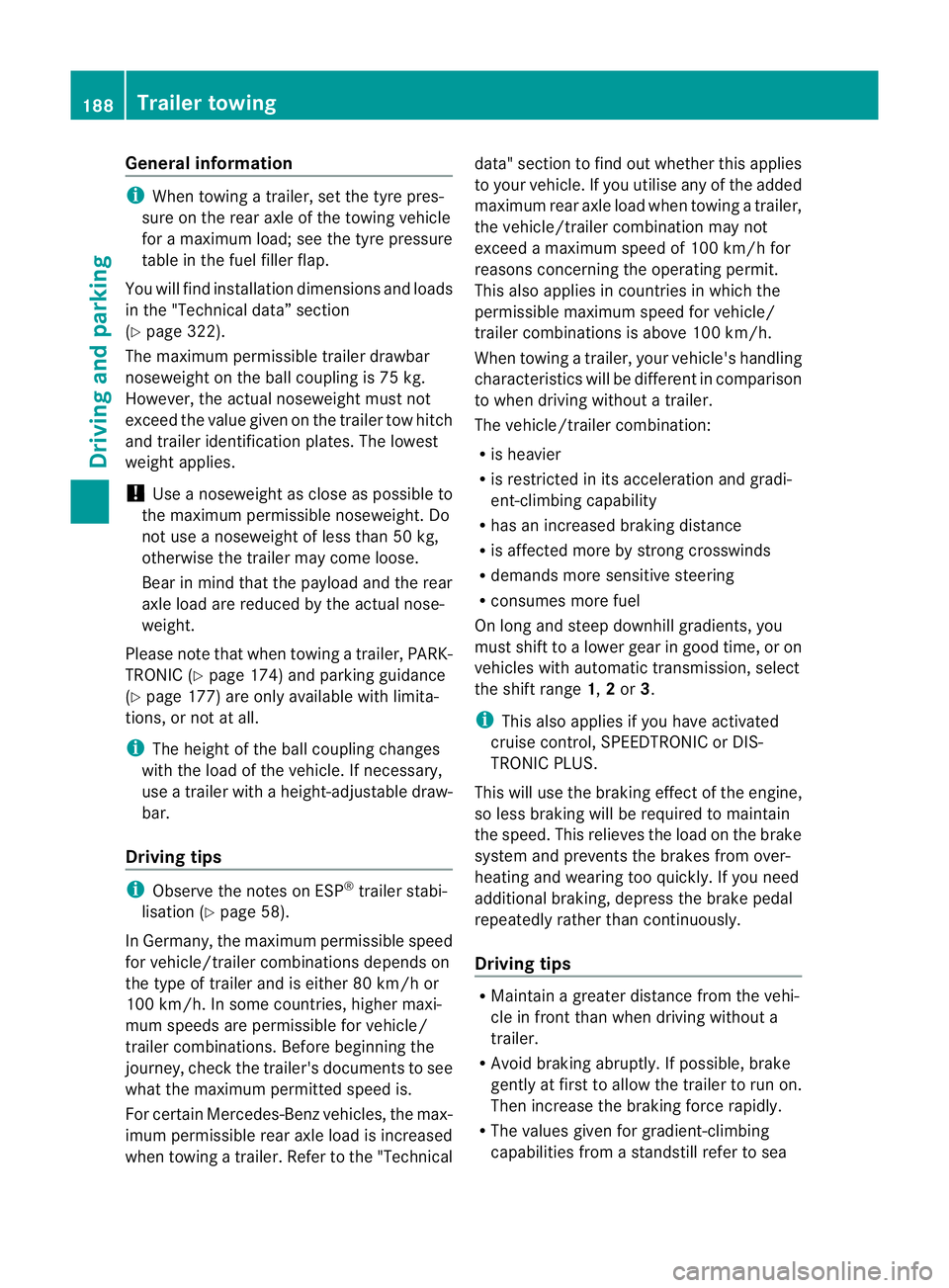
Gen
eral information i
When towing atrail er,s et the tyr epres-
sure on th erear axle of the towing vehicle
for am aximum load; se ethe tyr epressure
table in th efuel filler flap.
You will find installatio ndimensions and loads
in the "Technical data” section
(Y page 322).
The maximum permissible trailer drawbar
noseweight on the ball coupling is 75 kg.
However ,the actual noseweight must not
exceed the value given on the trailer tow hitch
and trailer identification plates. The lowest
weight applies.
! Use anoseweight as close as possible to
the maximum permissible noseweight .Do
not use anoseweight of less than 50 kg,
otherwise the trailer ma ycome loose.
Bear in min dthat the payload and the rear
axl eload ar ereduced by the actual nose-
weight.
Please not ethat when towing atrailer, PARK-
TRONIC (Y page 174) and parkin gguidance
(Y page 177 )are onl yavail ablew ith limita-
tions, or not at all.
i The height of the ball coupling changes
with the load of the vehicle. If necessary,
use atrailer wit haheight-adjustable draw-
bar.
Driving tips i
Observ ethe notes on ESP ®
trailer stabi-
lisation (Y page 58).
In Germany, the maximum permissible speed
for vehicle/ trailer combinations depends on
the type of trailer and is either 80 km/ hor
100 km/h. In some countries ,higher maxi-
mum speeds are permissible for vehicle/
trailer combinations. Befor ebeginnin gthe
journey ,check the trailer's documen tsto see
what the maximum permitted speed is.
For certain Mercedes-Benz vehicles, the max-
imum permissible rear axle load is increased
when towing atrailer. Refer to th e"Technical data
"section to fin dout whether this applies
to your vehicle. If you utilise any of the added
maximum rear axle load when towing atrailer,
th ev ehicle/ trailer combination may not
exceed amaximum spee dof100 km/h for
reasons concerning the operating permit.
This als oapplies in countries in which the
permissible maximum speed for vehicle/
trailer combinations is above 10 0km/h.
When towing atrailer, your vehicle's handling
characteristics wil lbedifferent in comparison
to when drivin gwithout atrailer.
Th ev ehicle/ trailer combination:
R is heavier
R is restricted in its acceleration and gradi-
ent-climbin gcapability
R has an increased braking distance
R is affected more by stron gcrosswinds
R demand smore sensitive steering
R consume smore fuel
On long and steep downhil lgradients ,you
must shift to alower gear in good time, or on
vehicles with automatic transmission ,select
the shift range 1,2or 3.
i This also applies if you have activated
cruise control, SPEEDTRONIC or DI S-
TRONIC PLUS.
This will use the brakin geffect of th eengine,
so les sbraking wil lberequired to maintain
the speed. This relieves the load on the brake
system and prevent sthe brakes from over-
heating and wearing too quickly .Ifyou need
additional braking, depress the brake pedal
repeatedly rather than con tinuously.
Driving tips R
Maintain agreater distance from th evehi-
cle in front than when driving without a
trailer.
R Avoid braking abruptly. If possible, brake
gently at first to allow the trailer to run on.
Then increase the braking force rapidly.
R The values given for gradient-climbing
capabilities from astandstill refer to sea 188
Trailer towingDrivin
gand pa rking
BA 20 7ECE ÄJ 2010 /1a; 1; 2, en-GB
mkalafa Version: 3.0.2.11 2010-01-26T13:03:22+01:00 -Seite 188
Page 225 of 333

Engine
Display messages Possible causes/consequences and
M Solutions
+ To
pup
coolant
See Own‐
er' sM an‐
ual Th
ec oolant leve listoo low.
X Top up th ecoolant ,obser ving the warning note sbefore
doin gso( Ypage 261).
X If th ecoolant needs toppin gupmoreo ften than usual ,have
the engin ecoolant system checked at aqualified specialist
workshop. ? Co
olant
Sto pv ehi‐
cle
Switch
engine off Th
ec oolant is to ohot.
Aw arning ton ealso sounds.
X Pull ove rand sto pthe vehicle safel yand switch off the
engine ,payin gattentio ntoroad and traffic conditions.
X Make sure that the air supply to the radiator is not blocked,
e.g. by snow, slush or ice.
X Wait until the display message disappears befor erestar ting
the engine. Otherwise, there is arisk of engine damage.
X Pay attention to the coolant tempera turedisplay.
X If the temperature increases again, visit aqualified special-
ist worksho pimmediately. Th
ep oly-V-belt ma yhave torn.
X Pull over and stop the vehicle safely and switch off the
engine, paying attention to road and traffic conditions.
X Open the bonnet.
X Check whethe rthe poly-V-belt is tor n.
If the poly-V -belt is torn:
! do not continue driving. The engine could otherwise over-
heat.
X Consult aqualified specialist workshop.
If the poly-V-belt is OK:
X Wait until the display messag edisappears before restarting
the engine. Otherwise, there is arisk of engine damage.
X Pay attention to the coolant tempera turedisplay.
X Visit aqualified specialist workshop. 222
Display messagesOn-board computer and displays
BA 207 ECE ÄJ 2010/1a; 1; 2, en-GB
mkalaf
aV ersion: 3.0.2.11
2010-01-26T13:03:22+01:00
-Seite 222
Page 226 of 333
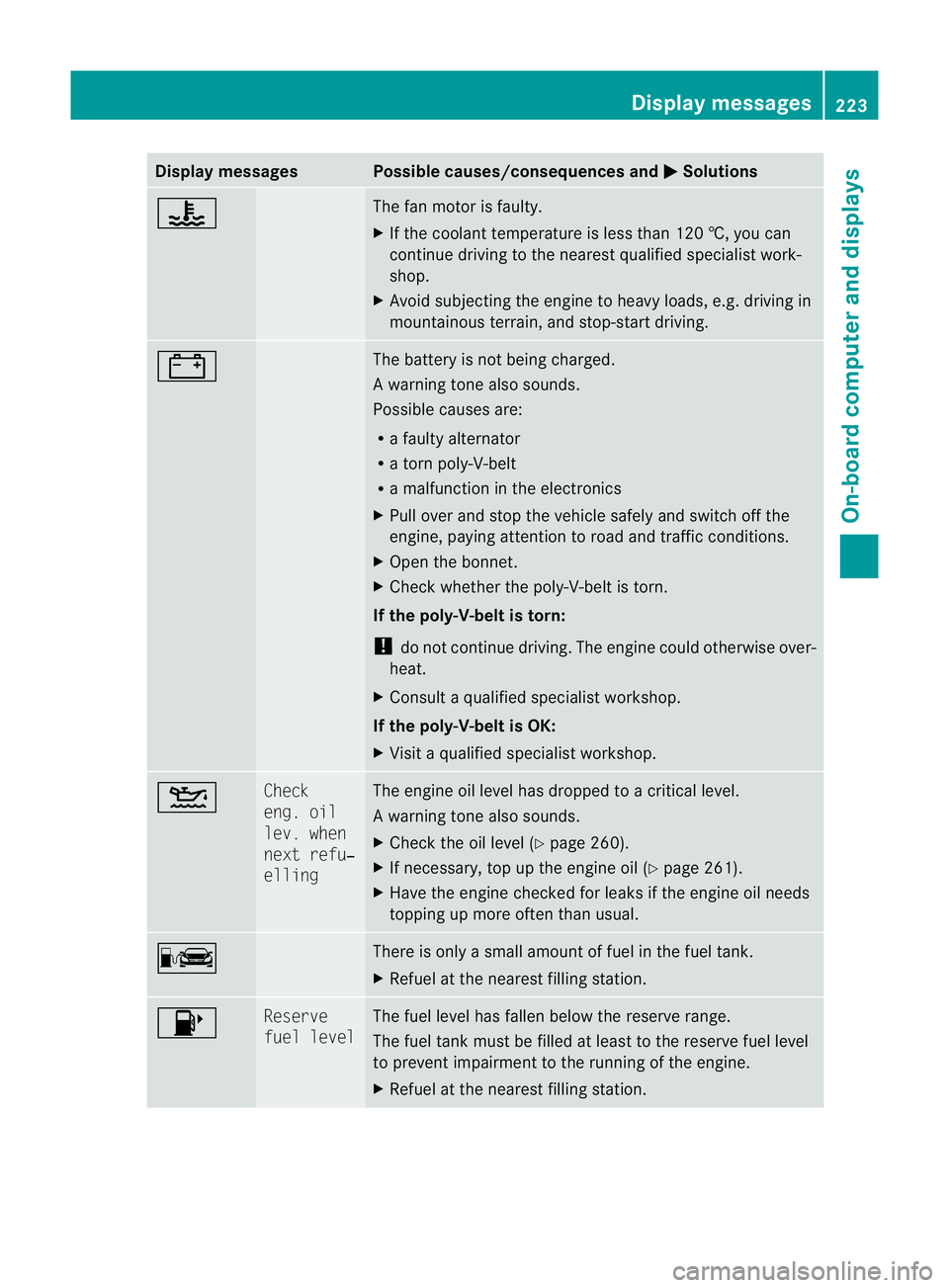
Displa
ymessages Possible causes/consequences and
M Solutions
? The fan motor is faulty.
X
If th ecoolant tem perature is less than 12 0†,you can
continue drivin gtothe nearest qual ified specialist work-
shop.
X Avoid subjecting th eenginetoh eavy loads, e.g. driving in
mountainous terrain, and stop-star tdriving. # Th
eb attery is not being charged.
Aw arning ton ealso sounds.
Possible causes are:
R af ault yalternator
R at orn poly-V-belt
R am alfunction in the elect ronics
X Pul lover and stop the vehicle safel yand switch off the
engine ,payin gattentio ntoroad and traffic conditions.
X Open the bonnet.
X Check whether the poly-V-belt is tor n.
If the poly-V -belt is torn:
! do not continue driving. The engine could otherwise over-
heat.
X Consult aqualified specialist workshop.
If the poly-V-belt is OK:
X Visit aqualified specialist workshop. 4 Check
eng. oil
lev. when
next refu‐
elling The engine oil level has dropped to
acriticallevel.
Aw arning ton ealso sounds.
X Chec kthe oil level (Y page 260).
X If necessary, top up the engin eoil (Y page 261).
X Hav ethe engin echecked for leak sifthe engin eoil needs
topping up more often than usual. C There is only
asmall amount of fue linthe fuel tan k.
X Refuel at the nearest filling station. 8 Reserve
fue
llevel Th
ef uel level has fallen below the reserve range.
The fuel tank must be filled at least to the reserve fuel level
to prevent impairment to the running of the engine.
X Refuel at the nearest filling station. Display messages
223On-board computer and displays
BA 207 ECE ÄJ 2010/1a; 1; 2, en-GB
mkalafaV ersion: 3.0.2.11
2010-01-26T13:03:22+01:0
0-Seite 223 Z
Page 233 of 333
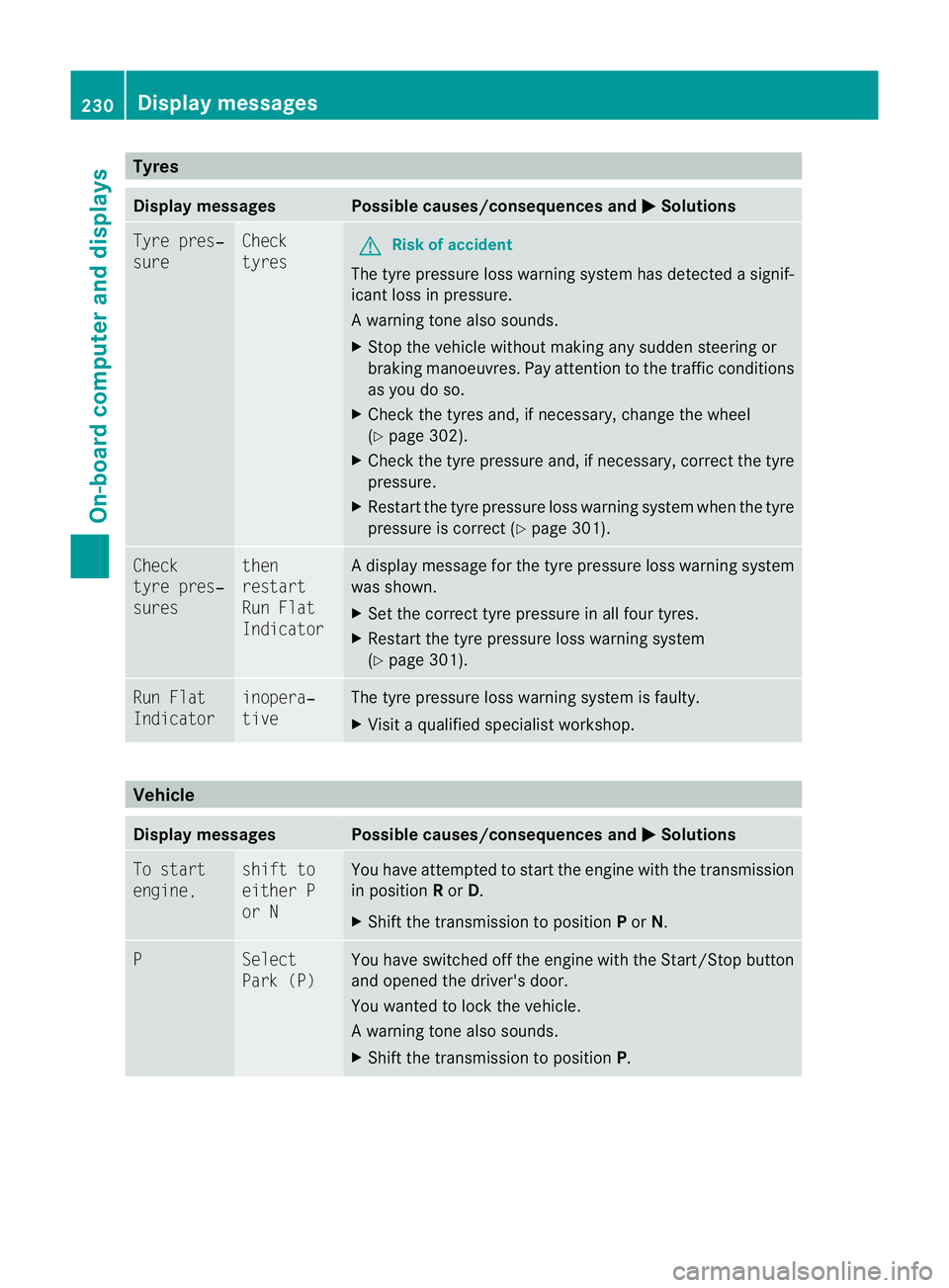
Tyres
Display messages Possible caus
es/consequences andM Solutions
Tyre pres‐
sure Check
tyres
G
Ris
kofa ccident
The tyr epressure loss warning system ha sdetected asignif-
ican tloss in pressure.
Aw arning ton ealso sounds.
X Stop th evehicle without making any sudde nsteering or
braking mano euvres.P ay attention to the traffic conditions
as you do so.
X Check the tyres and, if necessary ,change the wheel
(Y page 302).
X Chec kthe tyr epressure and ,ifnecessary, correc tthe tyre
pressure.
X Restart the tyr epressure loss warning system when th etyre
pressure is correct (Y page 301).Check
tyr
epres‐
sures then
restart
Run Flat
Indicator Ad
isplay message for the tyre pressure loss warnin gsystem
was shown.
X Set the cor recttyrep ressur eina ll four tyres.
X Restart th etyrep ressur eloss war ningsystem
(Y page 301). Ru
nF lat
Indicator inopera‐
tive Th
et yrep ressur eloss war ningsystem is faulty.
X Visit aq ualified specialist workshop. Vehicle
Display messages Possible causes/consequences and
M Solutions
To st
art
engine, shift to
either P
or N Yo
uh avea ttempted to startthe engin ewitht he transmiss ion
in position Ror D.
X Shift th etransmission to position Por N. P Select
Park (P) You have switched off the engine with the Star
t/Stop button
and opened the driver's door.
You wante dtolock the vehicle.
Aw arning ton ealso sounds.
X Shift th etransmissio ntoposition P. 230
Display messagesOn-boar
dcomputer and displays
BA 20 7ECE ÄJ 2010/1a; 1; 2, en-GB
mkalafa Version:3.0.2.11
2010-01-26T13:03:22+01:00
-Seite 230
Page 242 of 333
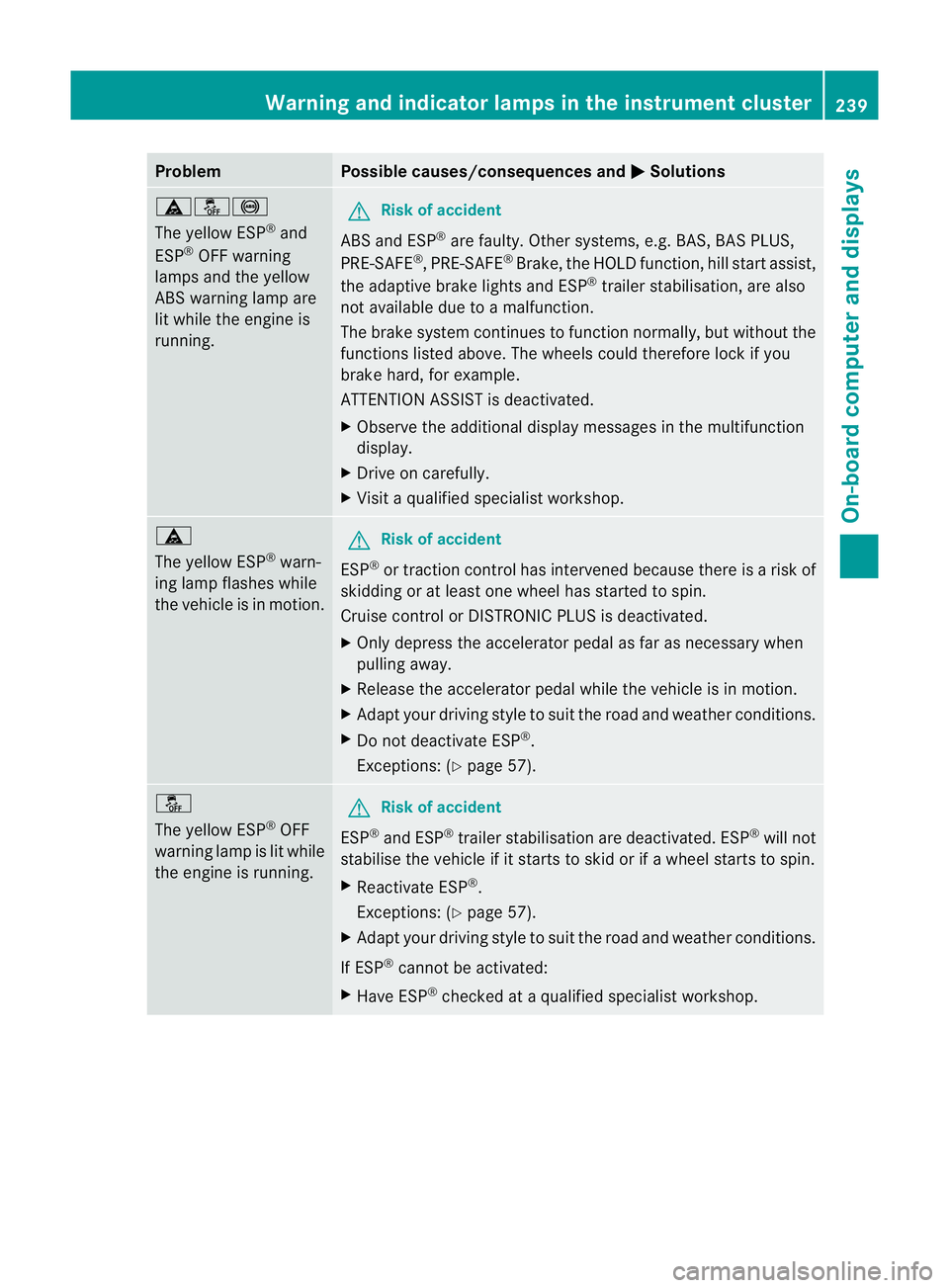
Problem Possible causes/consequences and
M Solutions
äå!
The yellow ESP
®
and
ESP ®
OFF warning
lamps and the yellow
AB Sw arning lamp are
lit while the engine is
running. G
Risk of accident
ABS and ESP ®
are faulty. Other systems, e.g. BAS ,BAS PLUS,
PRE-SAFE ®
,P RE-SAFE ®
Brake, the HOL Dfunction ,hill start assist,
th ea daptive brak elights and ESP ®
trailer stabilisation ,are also
not availabl edue to amalfunction.
The brake system continues to function normally, but without the
functions listed above. The wheels coul dtherefore lock if you
brake hard, for example.
ATTENTION ASSIST is deactivated.
X Observ ethe additional display messages in the multifunction
display.
X Drive on carefully.
X Visit aquali fieds pecialist workshop. ä
The yellow ESP
®
warn-
ing lamp flashes while
the vehicle is in motion. G
Risk of accident
ESP ®
or tra ction contro lhas intervened because ther eisarisk of
skidding or at least one wheel has started to spin.
Cruise control or DISTRONIC PLU Sisd eactivated.
X Only depress the accelerator pedal as far as necessar ywhen
pulling away.
X Release the accelerator pedal while the vehicle is in motion.
X Adap tyour drivin gstyle to suit the road and weather conditions.
X Do not deactivate ESP ®
.
Exceptions: (Y page 57). å
The yellow ESP
®
OFF
warning lamp is lit while
the engine is running. G
Risk of accident
ESP ®
and ESP ®
trailer stabilisation are deactivated .ESP ®
will not
stabilis ethe vehicle if it starts to skid or if awheel starts to spin.
X Reactivate ESP ®
.
Exceptions: (Y page 57).
X Adap tyour drivin gstyle to suit the road and weather conditio ns.
If ESP ®
cannot be activated:
X Have ESP ®
checked at aqualified specialist workshop. Warnin
gand indicator lam psin th einstru ment cluster
239On-board computer and displays
BA 207ECE ÄJ 2010 /1a;1;2,e n-GB
mkalafa Version: 3.0.2.11 2010-01-26T13:03:22+01:00-Seite 239 Z
Page 244 of 333
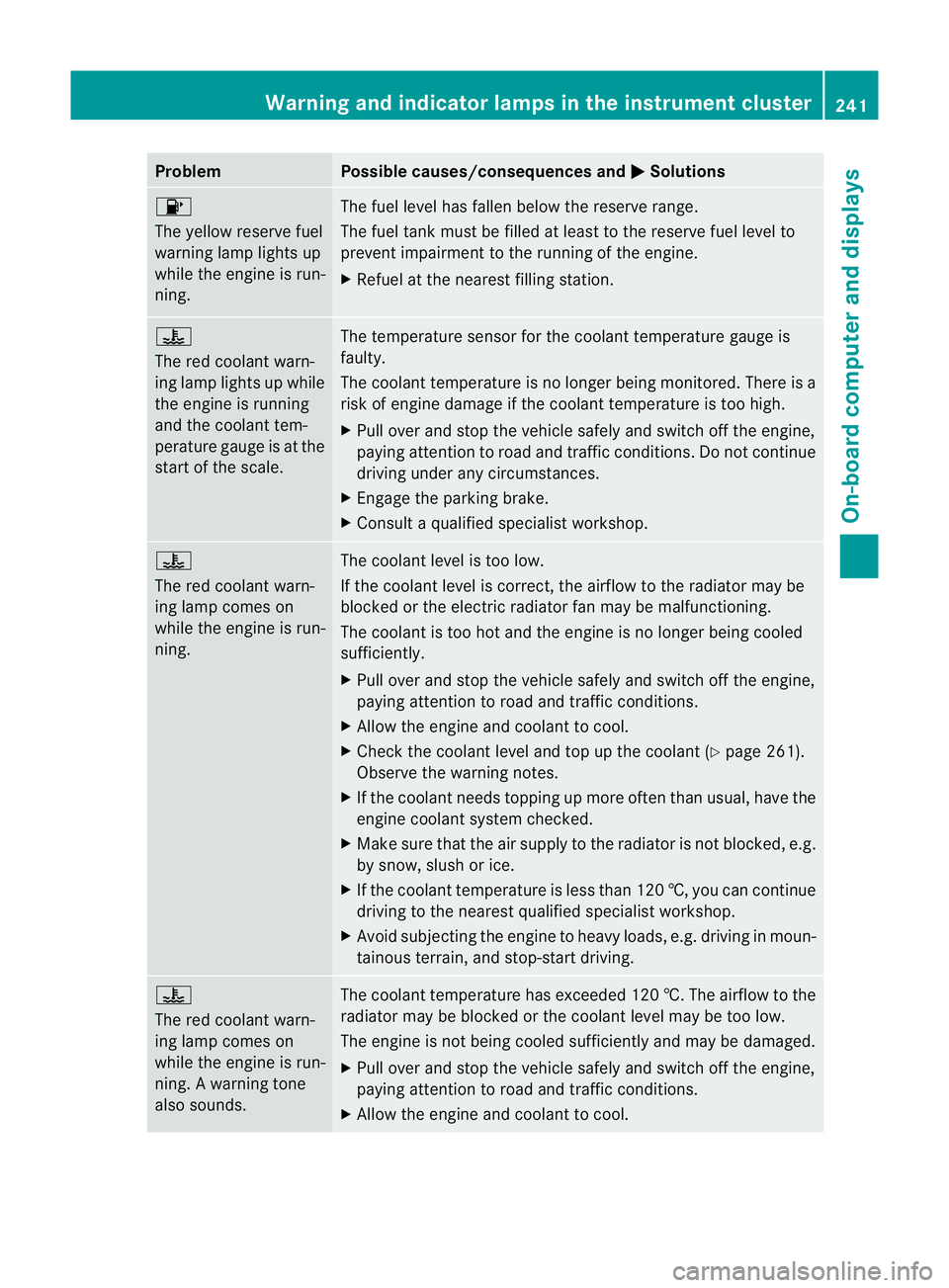
Problem Possible causes/consequences and
M Solutions
8
The yellow reserve fuel
warnin
glamp lights up
while the engine is run-
ning. The fuel level has fallen below the reserve range.
The fuel tank must be filled at least to the reserve fuel level to
prevent impairment to the running of the engine.
X Refuel at the nearest filling station. ?
The red coolant warn-
ing lamp lights up while
the engine is running
and the coolant tem-
perature gauge is at the
start of the scale.
The temperature senso
rfor the coolant temperatur egauge is
faulty.
The coolant temperature is no longer being monitored. There is a
risk of engine damage if the coolant temperature is too high.
X Pull over and stop the vehicle safely and switch off the engine,
paying attention to road and traffic conditions. Do not continue
driving under any circumstances.
X Engage the parking brake.
X Consult aqualified specialist workshop. ?
The red coolant warn-
ing lamp comes on
while the engine is run-
ning.
The coolant level is too low.
If the coolant level is correct, the airflow to the radiator may be
blocked or the electric radiator fan may be malfunctioning.
The coolant is too hot and the engine is no longer being cooled
sufficiently.
X Pull over and stop the vehicle safely and switch off the engine,
paying attention to road and traffic conditions.
X Allow the engine and coolant to cool.
X Check the coolant level and top up the coolant (Y page 261).
Observe the warning notes.
X If the coolant needs topping up more often than usual, have the
engine coolant system checked.
X Make sure that the air suppl ytot he radiator is not blocked, e.g.
by snow, slush or ice.
X If the coolant temperature is less than 12 0†,you can con tinue
driving to the neares tqualified specialist workshop.
X Avoid subjecting the engine to heavy loads ,e.g. driving in moun-
tainous terrain, and stop-s tart driving. ?
Th
er ed coolan twarn-
ing lamp comes on
while the engine is run-
ning. Awarning tone
also sounds. The coolant temperature has exceeded 120 †. The airflow to the
radiator may be blocked or the coolant level may be too low.
The engine is not being cooled sufficiently and may be damaged.
X Pull over and stop the vehicle safely and switch off the engine,
paying attention to road and traffic conditions.
X Allow the engine and coolant to cool. Warnin
gand indicator lam psin th einstru ment cluster
241On-board computer and displays
BA 207ECE ÄJ 2010 /1a;1;2,e n-GB
mkalafa Version: 3.0.2.11 2010-01-26T13:03:22+01:00-Seite 241 Z
Page 261 of 333
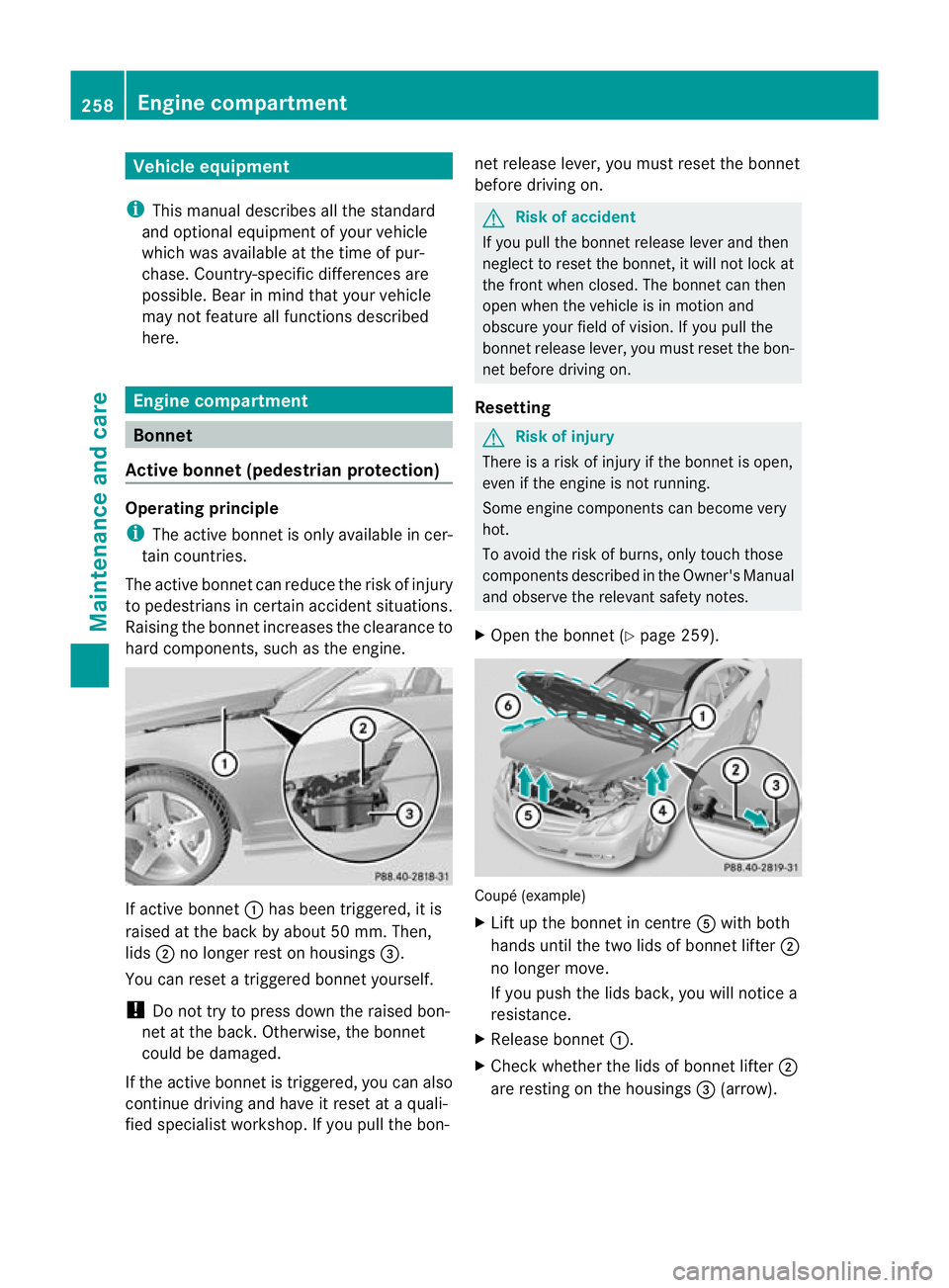
Vehicl
eequipment
i Thismanua ldesc ribe sallthe standard
and optional equipment of your vehicle
which wa savailable at th etime of pur-
chase. Countr y-specif ic differences are
possible. Bear in mind tha tyour vehicle
ma ynot featur eall function sdescribed
here. Engine comp
artment Bonnet
Active bonnet (pedestrian protection) Operating principle
i
The activ ebonnet is only available in cer-
tain coun tries.
The activ ebonnet can reduce the risk of injury
to pedestrian sincertain acciden tsituations.
Raising the bonnet increases the clearanc eto
har dcomponents, such as the engine. If active bonnet
:has been triggered, it is
raised at the back by about 50 mm .Then,
lids ;no longer rest on housings =.
You can reset atriggere dbonnet yourself.
! Do not tr ytopressdown the raised bon-
net at the back .Otherwi se,the bonnet
could be damaged.
If the act iveb onnet is triggered, yo ucan also
continue driving and have it reset at aquali-
fied specialis tworkshop. If you pull the bon- net release lever, you must reset the bonnet
befor edriving on. G
Ris
kofa ccident
If you pull the bonnet release lever and then
neglect to reset the bonnet, it will not lock at
the front when closed. The bonnet can then
open when the vehicle is in motion and
obscure your field of vision. If you pull the
bonnet release lever, you must reset the bon-
net before driving on.
Resetting G
Risk of injury
There is arisk of injur yifthe bonnet is open,
even if the engin eisnot running.
Som eengine compone ntsc an become very
hot.
To avoid the risk of burns, only touch those
components described in the Owner's Manual
and observe the relevant safety notes.
X Open the bonnet (Y page 259). Coupé (example)
X
Lift up the bonnet in centre Awith both
hands until the two lids of bonnet lifter ;
no longer move.
If you push the lids back, you will notice a
resistance.
X Releas ebonnet :.
X Check whether the lids of bonnet lifter ;
ar er estin gont he housings =(arrow). 258
Engine compartmentMaintenance and care
BA 20
7ECE ÄJ 2010 /1a; 1; 2, en-GB
mkalafa Version: 3.0.2.11 2010-01-26T13:03:22+01:00 -Seite 258
Page 263 of 333

X
Pull release lever :on the bonnet.
The bonnet is released.
! Make sure that the windscreen wiper sare
not folde daway from the windscreen .Oth-
erwise, yo ucould damage the windscreen
wipers or the bonnet. X
Reach int othe gap, pull bonnet catch han-
dle ;up and lift the bonnet.
Closin gthe bonnet G
Ris
kofi njury
Make sure tha tnobody can becom etrapped
as you close th ebonnet.
X Lower the bonnet and let it fal lfrom a
height of approximatel y20c m.
X Check that th ebonnet has engaged prop-
erly.
If the bonnet can be raised slightly ,itisn ot
properly engaged. Open it again and close
it with alittle more force. Engine oil
Notes on the oil level Depending on drivin
gstyle, the vehicle con-
sumes amaximum of 0.8 loil per 100 0km.
Th eo il consumption may be higher than this
when the vehicle is new or if you frequently
drive at high engine speeds.
When checking the oil level:
R park the vehicle on alevel surface.
R the engine should be switched off for at
least fiv eminutes if the engine is at normal
operating temperature.
R the engine should be switched off for at
least thirt yminutes if the engine is not at
normal operating temperature, e.g. if the
engine was only started briefly.
Checking the oil level using the oil dip-
stick Depending on the engine, the oil dipstick may
be installed at
adifferent location. E3
50 (example)
X Pull oi ldipstick :out of the oil dipstick
tube.
X Wipe off oil dipstick :.
X Slowly insert oil dipstick :into the oil dip-
stick tube to the stop, and take it out again.
The oil level is correc tifthe level is between
MIN mark =and MAX mark ;.
X Top up the oil if necessary. 260
Engine compartmentMaintenance and care
BA 20
7ECE ÄJ 2010 /1a;1;2,e n-GB
mkalafa Version: 3.0.2.11 2010-01-26T13:03:22+01:00-Seite 260
Page 264 of 333

Adding engine oil
H
Environmenta
lnote
When toppin guptheoil, tak ecaren ot to spill
any .Ifo il enter sthe soil or waterways, it is
harmful to the environmen t.Engine oil cap (example)
X
Turn cap :anti-clockwise and remove it.
X Top up with the amount of oil required.
Fill carefully to the maximum mark on the oil
dipstick.
i Depending on the engine, the difference
between the minimum mark and the maxi-
mum mark is approximately 1.5 –2litres.
! Do not add too muc hoil. If the oil level is
above the "max "mark on the dipstick, too
much oil has been added. This can lead to
damage to the engine or the catalytic con-
verter .Have excess oil siphoned off.
Further information on engin eoil
(Y page 315).
X Replac ecap : on the filler nec kand
tighten clockwise.
Ensure that the cap locks int oplace
securely. Checking and addin
gother service
products
Checking th ecoolan tlevel Only check th
ecoolant leve lwhen th evehicle
is on alevel surface and th eengine has cooled
dow n.
X Tur nthe ke ytop osition 2(Y page 135) in
th ei gnitio nlock.
On vehicles with KEYLESS -GO, press the
Star t/Stop butto ntwice (Y page 135).
X Check the coolant temperature display in
the instrument cluster. G
Risk of injury
The cooling system is pressurised. Therefore,
only unscrew the cap once the engine has
cooled down. The coolant temperature gauge
must display less than 70 †.Otherwi se,you
could be scalded if ho tcoolant escapes. X
Slowl yturn cap :half aturna nti-clock-
wis eand allo wexcess pressure to escape.
X Turn cap :further anti-clockwis eand
remove it.
If the coolant is at the level of marker bar
= in the filler neck when cold, ther eis
enough coolan tincoolant expansion
tank ;.
If the coolant is approximately 1. 5cm
higher when it is warm, ther eisenough
coolant in coolant expansion tank ;. Engin
ecompartment
261Maintenance and care
BA 207ECE ÄJ 2010/1a; 1; 2, en-GB
mkalafa Version:3.0.2.11
2010-01-26T13:03:22+01:0
0-Seite 261 Z